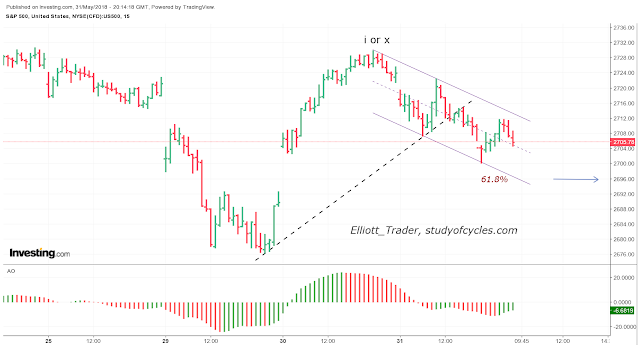The weekly chart of the S&P500, plotted along with the Elliott Wave Oscillator, shown below, now shows that with 116 candles on the chart (hard to get closer to the recommended 120 candles on any different time frame), the Elliott Wave Oscillator has just peeked under the zero line at -2, to likely indicate a fourth wave location. Bullseye!
 |
| S&P500 Cash Weekly - The Eight Fold Path |
It is indeed possible to count a completed triangle at this location, and that would alternate well with either type of correction for wave
2 (whether it was a flat or simple zigzag). The chart above is labeled in accordance with three principles:
A. Proper degree labeling.
B. All wave threes must entirely be above their 0 - two trend lines.
C. Each larger numbered wave (1 - 5) should be on an opposite side of the blue EMA-34.
With regards to proper degree labeling, wave minute
i of Minor
3, is just short of 100% the length of Minor
1. Because it is shorter than Minor
1, it is of a lower degree. As I wrote in an earlier post, this is the only way I can find to preserve degree labeling in the third wave. Then, each of the minuet waves
.i -
.v is shorter than the minute
i wave. Clearly minute
iii of Minor
3 is shorter than Minor
1, as is minute
v.
And, with regard to trend lines, clearly, all of wave Minor
3, is above the
0 -
2 trend line. But, importantly, all of wave minute
iii is above the Minor
2 - minute
ii trend line, as well. Finally, all of minuet
.iii is above the trend line from Minor
2 to minuet
.ii, and they all work out as Neely's guideline suggests.
Each of the above items is a measurable or observable characteristic of the wave. As such, these criteria are objective in that any person can observe them and replicate them without a "secret sauce", expensive tutorial, or supposed guru needed to interpret them. Furthermore, certain web-sites and other pundits have been calling for a crash which has not occurred just yet (although, granted the risks are exceedingly high with each day that passes).
On the other hand, this site said "a triangle could help even out the point distances between waves 2 and waves 4." And, further, since the
a wave down of the triangle is longer in points than even Intermediate wave (4) at the February, 2016 low, "a triangle could help even out the point differences to avoid a degree conflict in terms of the number of points traveled between Minor 4 and Intermediate (4), because a triangle is always measured to it's (e) wave."
Was a triangle the right call? Certainly, the daily whip and foam is consistent with one. And, at this point in time, the structure we have shown certainly
looks like a triangle. So far, so good, and we note that many other web sites are now getting on board with the whole triangle idea - well after we did.
So, as I've written about before, then, this triangle could expand once (or breathe) and create a slightly deeper
d wave, to be followed by a more complex
e wave, later. That will need to be tracked in real time.
For my part, I'm going to reduce my frequency of posts for a while, and let things play out. While doing so, this might be an excellent chance for you to try your hand at The Eight Fold Path Method for yourself on these waves, and see what they look like. Just remember to give the corrections lots of time, like we did with the most recent
(b) wave - or
e wave - example.
Ultimately, what would be great to see would be new highs that diverge with the Advance/Decline line, and possibly a real daily outside "key reversal" candle stick that starts a down wave from a new all-time high without the presence of large gaps that currently appear at the former all-time-high in the daily cash chart.
Does this have to happen? No. First, as I said, the triangle might expand more to make the larger version of the triangle. Remember, the very purpose of triangles is to
take up time, and move price sideways. Then, some markets might make the new highs, other markets might truncate. It's all part of The Fourth Wave Conundrum that happens at every degree of trend.
Take it step-by-step and let's see how it goes.
Have a good weekend.
TraderJoe















